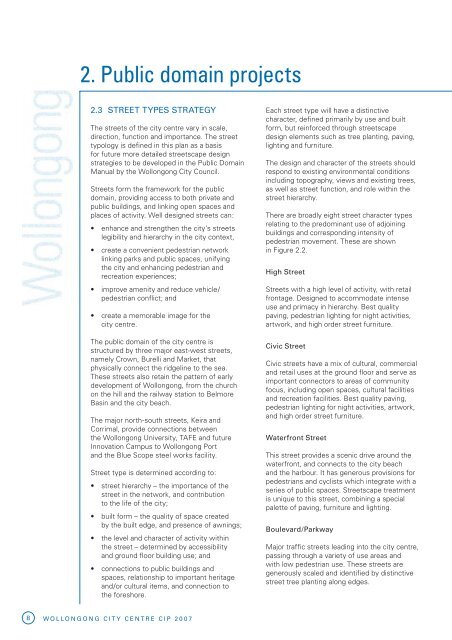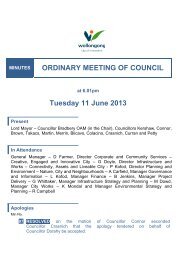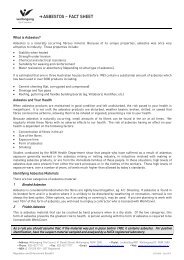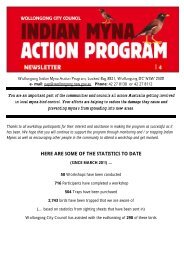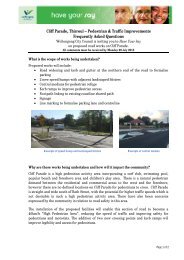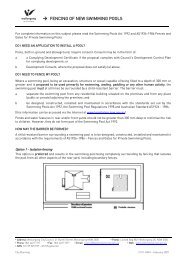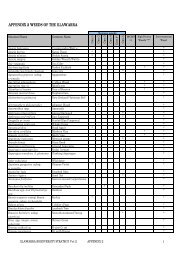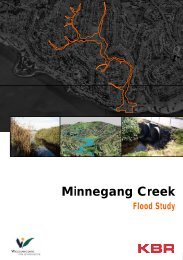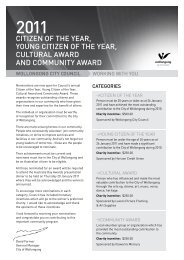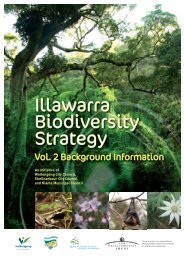Civic Improvement Plan - Wollongong City Council - NSW Government
Civic Improvement Plan - Wollongong City Council - NSW Government
Civic Improvement Plan - Wollongong City Council - NSW Government
- No tags were found...
You also want an ePaper? Increase the reach of your titles
YUMPU automatically turns print PDFs into web optimized ePapers that Google loves.
2. Public domain projects2.3 STREET TYPES STRATEGYThe streets of the city centre vary in scale,direction, function and importance. The streettypology is defined in this plan as a basisfor future more detailed streetscape designstrategies to be developed in the Public DomainManual by the <strong>Wollongong</strong> <strong>City</strong> <strong>Council</strong>.Streets form the framework for the publicdomain, providing access to both private andpublic buildings, and linking open spaces andplaces of activity. Well designed streets can:• enhance and strengthen the city’s streetslegibility and hierarchy in the city context,• create a convenient pedestrian networklinking parks and public spaces, unifyingthe city and enhancing pedestrian andrecreation experiences;• improve amenity and reduce vehicle/pedestrian conflict; and• create a memorable image for thecity centre.The public domain of the city centre isstructured by three major east-west streets,namely Crown, Burelli and Market, thatphysically connect the ridgeline to the sea.These streets also retain the pattern of earlydevelopment of <strong>Wollongong</strong>, from the churchon the hill and the railway station to BelmoreBasin and the city beach.The major north-south streets, Keira andCorrimal, provide connections betweenthe <strong>Wollongong</strong> University, TAFE and futureInnovation Campus to <strong>Wollongong</strong> Portand the Blue Scope steel works facility.Street type is determined according to:• street hierarchy – the importance of thestreet in the network, and contributionto the life of the city;• built form – the quality of space createdby the built edge, and presence of awnings;• the level and character of activity withinthe street – determined by accessibilityand ground floor building use; and• connections to public buildings andspaces, relationship to important heritageand/or cultural items, and connection tothe foreshore.Each street type will have a distinctivecharacter, defined primarily by use and builtform, but reinforced through streetscapedesign elements such as tree planting, paving,lighting and furniture.The design and character of the streets shouldrespond to existing environmental conditionsincluding topography, views and existing trees,as well as street function, and role within thestreet hierarchy.There are broadly eight street character typesrelating to the predominant use of adjoiningbuildings and corresponding intensity ofpedestrian movement. These are shownin Figure 2.2.High StreetStreets with a high level of activity, with retailfrontage. Designed to accommodate intenseuse and primacy in hierarchy. Best qualitypaving, pedestrian lighting for night activities,artwork, and high order street furniture.<strong>Civic</strong> Street<strong>Civic</strong> streets have a mix of cultural, commercialand retail uses at the ground floor and serve asimportant connectors to areas of communityfocus, including open spaces, cultural facilitiesand recreation facilities. Best quality paving,pedestrian lighting for night activities, artwork,and high order street furniture.Waterfront StreetThis street provides a scenic drive around thewaterfront, and connects to the city beachand the harbour. It has generous provisions forpedestrians and cyclists which integrate with aseries of public spaces. Streetscape treatmentis unique to this street, combining a specialpalette of paving, furniture and lighting.Boulevard/ParkwayMajor traffic streets leading into the city centre,passing through a variety of use areas andwith low pedestrian use. These streets aregenerously scaled and identified by distinctivestreet tree planting along edges.8 WOLLONGONG CITY CENTRE CIP 2007


